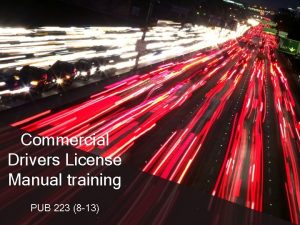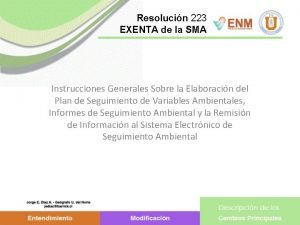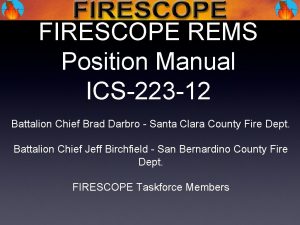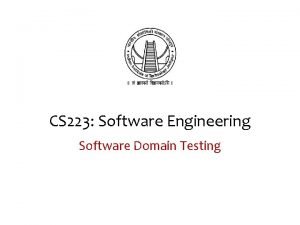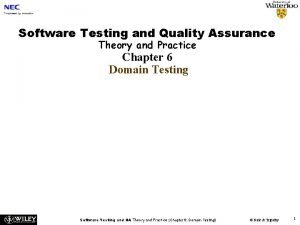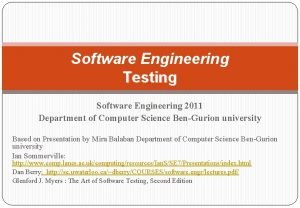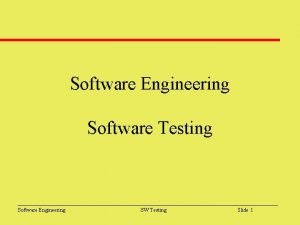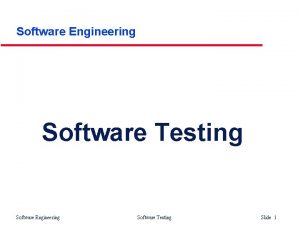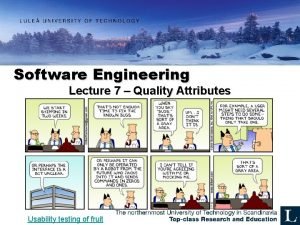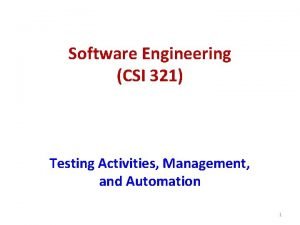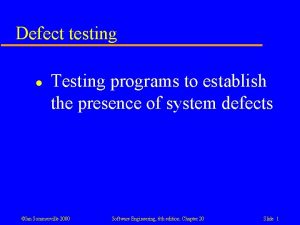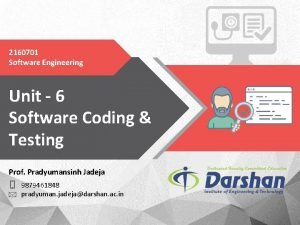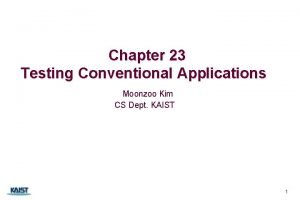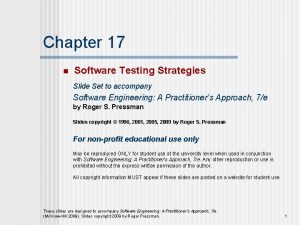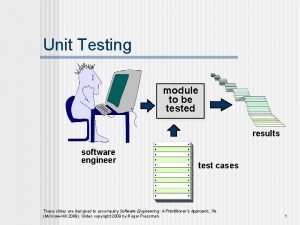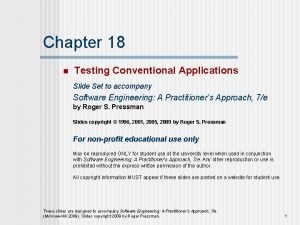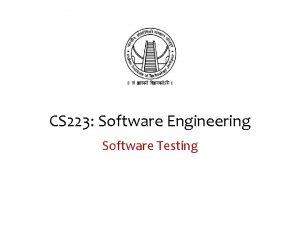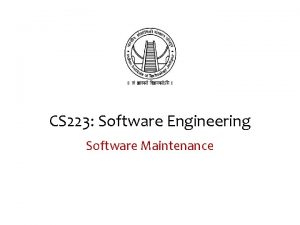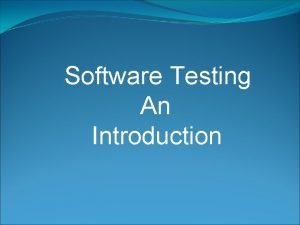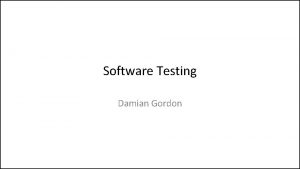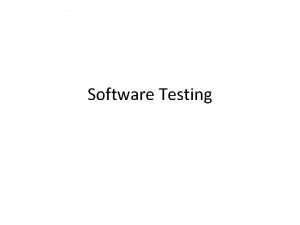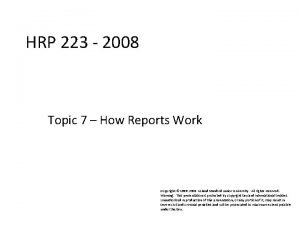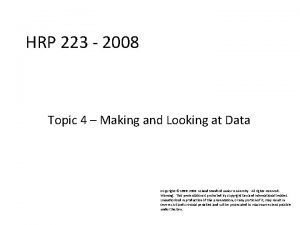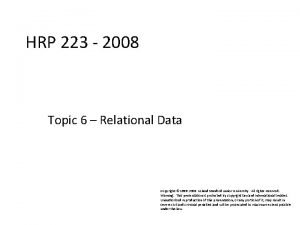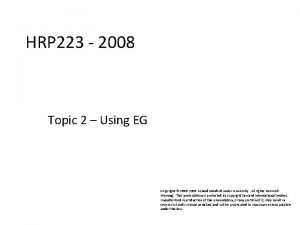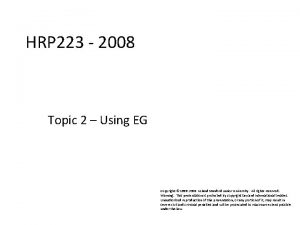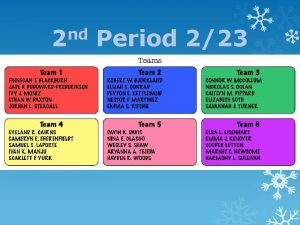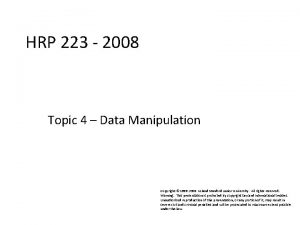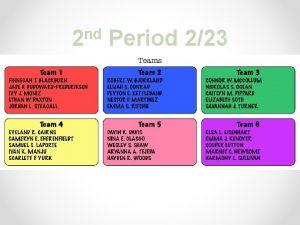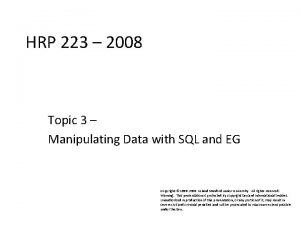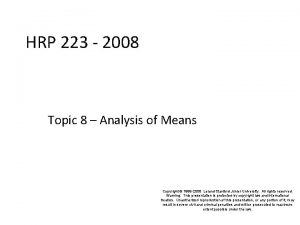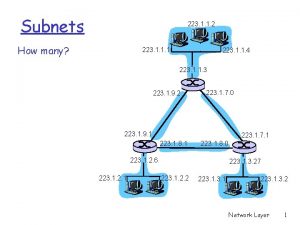CS 223 Software Engineering Software Domain Testing Domain































- Slides: 31

CS 223: Software Engineering Software Domain Testing

Domain Error • Two fundamental elements of a program o Input domain: The set of all input data to the program o Program path: A sequence of instructions from entry to exit ØFeasible path: If there exists input data which causes the path to execute. ØInfeasible path: No input data exists to cause the path to execute. • Howden identified 2 classes of errors by combining input domain and program paths. o Computation error o Domain error • Computation error o A computation error occurs when a specific input data causes the correct path to execute, but the output value is wrong. • Domain error o A domain error occurs when a specific input data causes the program to execute a wrong (i. e. undesired) path. 2

Domain Error • Idea o An input causes a path to execute. o Different input data (i. e. a set of inputs) cause the same path to execute. o Domain: A domain is a set of input values for which the program performs the same computation for every member of the set. o We are interested in maximal domains such that the program performs different computations in different domains. 3

Program Domain Error 4

Domain Error • A program is considered as an input classifier. • A program is said to have a domain error if it incorrectly performs input classification. o Wrong classification: This means a wrong path is executed for a specific input data. 5

Testing for Domain Errors • The idea of domain testing was first studied by White and Cohen. • Domain testing differs from control/data flow testing. • Flashback: control/data flow testing o Note: No assumption is made about any kind of error in the program. o Draw a graph – control flow or data flow. o Select paths based on path selection criteria: statement, branch, alluse. . . o Generate input data from the selected paths. • In contrast, in domain testing o One identifies a category of faults, known as domain errors. • We will discuss the following. o Sources of domain o Types of domain errors o Selecting test data to reveal domain errors 6

Sources of Domains int codedomain(int x, int c, d, k c = x + y; if (c > 5) d else d if (d >= c + else return(k); } int y){ = c - x/2; = c + x/2; 2) k = x + d/2; k = y + d/4; A function to explain program domains. 7

Domain Error Control flow graph rep. of the function 8

Domain Error P 2 (P 1 = TRUE) P 2 (P 1 = FALSE) 9

Types of Domain Errors • Recall that o A domain is a set of values for which the program performs identical computations. o A domain can be represented by a set of predicates. Individual elements of a domain satisfy the corresponding predicates. • From a geometrical perspective, a domain is defined by a set of constraints, called boundary inequalities. • The properties of a domain are discussed in terms of the properties of its boundaries. o Closed boundary o Open boundary o Closed domain o Open domain o Extreme point o Adjacent domain 10

Types of Domain Errors • Closed boundary o A boundary is said to be closed if the points on the boundary are included in the domain of interest. ØExample: Consider the TT domain and the boundary defined by the inequality P 2: x ≤ -4. This is a closed boundary of domain TT. • Open boundary o A boundary is said to be open if the points of the boundary do not belong to the domain of interest. ØExample: Consider the domain TT and its boundary defined by the inequality P 1: x + y > 5. This is an open boundary of the domain TT. • Closed domain o A domain is said to be closed if all of its boundaries are closed. • Open domain o A domain is said to be open if some of its boundaries are open. 11

Types of Domain Errors • Extreme point o An extreme point is a point where two or more boundaries cross. • Adjacent domains o Two domains are said to be adjacent if they have a boundary inequality in common. 12

Types of Domain Errors • Note o A program path will have a domain error if there is incorrect formulation of a path predicate. o An incorrect predicate expression causes a boundary segment to Ø be shifted from its correct position, or Ø have an incorrect relational operator • A domain error can be caused by o An incorrectly specified predicate, or o An incorrect assignment which affects a variable used in the predicate. • We focus on the following kinds of boundary errors. o Closure error o Shifted-boundary error o Tilted-boundary error 13

Types of Domain Errors • Closure error o A closure error occurs if a boundary is open when the intention is to have a closed boundary, or vice versa. o Example: The relational operator ≤ is implemented as <. • Shifted-boundary error o A shifted boundary error occurs when the implemented boundary is parallel to the intended boundary. o Example: Let the intended boundary be x + y > 4, whereas the actual boundary is x + y > 5. • Tilted-boundary error o A tilted-boundary error occurs if the constant coefficients of the variables in a predicate defining a boundary take up wrong values. o Example: Let the intended boundary be x + 0. 5*y > 5, whereas the actual boundary is x + y > 5. 14

ON and OFF Points • Idea o Data points on or near a boundary are most sensitive to domain errors. o Sensitive means a data point falling in the wrong domain. o The objective is to Øidentify the data points most sensitive to domain errors so that errors can be detected by examining the program with those input values. o Define two kinds of data points: ON and OFF. 15

ON and OFF Points • ON point o It is a point on the boundary or very close to the boundary. ØIf a point can be chosen to lie exactly on the boundary, choose it. ØThis requires the boundary inequality to have an exact solution. ØIf an inequality leads to an approximate solution, choose a point very close to the boundary. o Example: Consider the boundary x + 7*y ≥ 6. ØFor x = -1, the predicate gives us an exact solution of y = 1. Therefore the point (-1, 1) lies on the boundary. ØFor x = 0, the predicate leads us to an approximate solution y = 0. 8571428…. ØSince y does not have an exact solution, we can truncate it to 0. 857 or round it off to 0. 858. ØNotice that (0, 0. 857) does not satisfy the predicate, whereas (0, 0. 858) does satisfy. Thus, (0, 0. 858) is an ON point which lies very close to the boundary. § The on point lies outside the domain. 16

ON and OFF Points • OFF point o An OFF point of a boundary lies away from the boundary. o While choosing an OFF point, we must consider whether the boundary is open or closed w. r. t. the domain of interest. ØOpen: An OFF point of the boundary is an interior point inside the domain within an ε-distance from the boundary. (ε ≡ small) ØClosed: An OFF point of that boundary is an exterior point outside the boundary with an ε-distance. o Example (Closed): Consider a domain D 1 with a boundary x + 7*y ≥ 6. An OFF point lies outside the domain. (-1, 0. 99) lies outside D 1. o Example (Open): Consider a domain D 2 that is adjacent to D 1 above with an open boundary x + 7*y < 6. (-1, 0. 99) lies inside D 2. 17

ON and OFF Points • Summary of ON and OFF points o For a closed boundary: Ø an ON point lies within the domain of interest, whereas Ø an OFF point lies in an adjacent domain. o For an open boundary, Ø an ON point lies in an adjacent domain, whereas Ø an OFF point lies within the domain of interest. 18

ON and OFF Points 19

Test Selection Criterion • For each domain and for each boundary o select three points A, C, and B in an ON-OFF-ON sequence. • Consider the following kinds of errors. o Closed inequality boundary ØBoundary shift resulting in a reduced domain ØBoundary shift resulting in an enlarged domain ØBoundary tilt ØClosure error o Open inequality boundary ØBoundary shift resulting in a reduced domain ØBoundary shift resulting in an enlarged domain ØBoundary tilt ØClosure error o Equality boundary 20

Test Selection Criterion • Closed inequali ty boundar y o Boun dary shift resulti ng in a reduc ed domai n Boundary shift resulting in a reduced domain (closed inequality). 21 Test data Actual output Expected output Fault detected A f 1(A) No B f 1(B) No C f 2(C) f 1(C) Yes Table 6. 2: Detection of boundary shift resulting in a reduced domain (closed inequality).

Test Selection Criterion • Closed inequali ty bounda ry Boundary shift resulting in an enlarged domain (closed inequality). 22 Test data Actual output Expected output Fault detected A f 1(A) f 2(A) Yes B f 1(B) f 2(B) Yes C f 2(C) No Detection of boundary shift resulting in an enlarged domain (closed inequality).

Test Selection Criterion • Closed inequali ty boundar y o Tilted boun dary 23 Test data Actual output Expected output Fault detected A f 1(A) No B f 1(B) f 2(B) Yes C f 2(C) No Detection of tilted boundary (closed inequality).

Test Selection Criterion • Closed inequa lity bound ary o Clos ure erro r Test data Actual output Expected output Fault detected A f 2(A) f 1(A) Yes B f 2(B) f 1(B) Yes C f 1(C) No Detection of closure error (closed inequality). 24

Test Selection Criterion • Open inequalit y boundar y o Bound ary shift resulti ng in a reduc ed domai n Test data Actual output Expected output Fault detected A f 2(A) f 1(A) Yes B f 2(B) f 1(B) Yes C f 1(C) No Detection of boundary shift resulting in a reduced domain (open inequality). 25

Test Selection Criterion • Open inequality boundary o Boundar y shift resultin g in an enlarge d domain Test data Actual output Expected output Fault detected A f 2(A) No B f 2(B) No C f 1(C) f 2(C) Yes Detection of boundary shift resulting in an enlarged domain (open inequality). 26

Test Selection Criterion • Open inequa lity bound ary o Tilte d bou nda ry Test data Actual output Expected output Fault detected A f 2(A) f 1(A) Yes B f 2(B) No C f 1(C) No Detection of tilted boundary (open inequality). 27

Test Selection Criterion • Open inequalit y boundary o 2. d Closur e error Test data Actual output Expected output Fault detected A f 1(A) f 2(A) Yes B f 1(B) f 2(B) Yes C f 2(C) No Detection of closure error (open inequality). 28

Test Selection Criterion • Equality border 29

Summary • Two kinds of program error: computation errors and domain errors • Domain: A set of inputs for which the program executes the same path. • Domain error: An input value causes the program to execute the wrong path. • A program is viewed as an input classifier. • Each domain is identified by a set of boundaries, and each boundary is expressed as a boundary condition. • Properties of boundaries: closed, open, closed domain, … • Three kinds of boundary errors were identified. o closure error, shifted boundary, tilted boundary • ON and OFF points • Test selection criterion: For each domain and for each boundary, select three points A, C, and B in an ON-OFF-ON sequence. 30

Thank you Next Lecture: System Testing
 Domain testing example
Domain testing example Types of domain testing
Types of domain testing Dl11cd
Dl11cd Res 223 sma
Res 223 sma Hqda exords
Hqda exords Ics 223-12
Ics 223-12 Logic based testing in software testing
Logic based testing in software testing Du path testing
Du path testing Anuj magazine
Anuj magazine Cause effect graph for triangle problem
Cause effect graph for triangle problem Control structure testing in software engineering
Control structure testing in software engineering Decision table testing in software testing
Decision table testing in software testing Decision table based testing
Decision table based testing Decision table for triangle problem
Decision table for triangle problem Rigorous testing in software testing
Rigorous testing in software testing Testing blindness in software testing
Testing blindness in software testing Domain testing
Domain testing Domain closure in software testing
Domain closure in software testing User testing software engineering
User testing software engineering Types of testing in software engineering
Types of testing in software engineering Interface testing in software engineering
Interface testing in software engineering Defect testing in software engineering
Defect testing in software engineering User testing software engineering
User testing software engineering Testing activities in software engineering
Testing activities in software engineering Cluster testing in software engineering
Cluster testing in software engineering Coding and testing in software engineering
Coding and testing in software engineering Prime path coverage calculator
Prime path coverage calculator What is regression testing in software engineering
What is regression testing in software engineering Module testing in software engineering
Module testing in software engineering Defect testing in software engineering
Defect testing in software engineering Testing conventional applications in software engineering
Testing conventional applications in software engineering System requirements document
System requirements document


